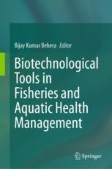Search
Search Results
-
Cold tolerance of the mealybug parasitoid Anagyrus vladimiri
We investigated the lower thermal limits of Anagyrus vladimiri Triapitsyn (Hymenoptera: Encyrtidae), a natural enemy of mealybugs. Parasitoids were...

-
Differential gene expression and microRNA profile in corpora allata-corpora cardiaca of Aedes aegypti mosquitoes with weak juvenile hormone signalling
The corpora allata - corpora cardiaca (CA-CC) is an endocrine gland complex that regulates mosquito development and reproduction through the synthesis...

-
Cold storage effects on biological parameters of Telenomus remus, a promising egg parasitoid of Spodoptera frugiperda, reared on Spodoptera litura eggs
Telenomus remus (Nixon) is a promising egg parasitoid for the management of Spodoptera frugiperda (J. E. Smith). This species has been successfully...

-
Girdling behavior of the longhorn beetle modulates the host plant to enhance larval performance
BackgroundPreingestive behavioral modulations of herbivorous insects on the host plant are abundant over insect taxa. Those behaviors are suspected...

-
Seasonal Development of Plant Bugs (Heteroptera, Miridae): Subfamily Bryocorinae
Data on seasonal development of plant bugs from subfamily Bryocorinae (Miridae) are reviewed and analyzed. All of the species of bryocorines whose...
-
Mitochondria as a target and central hub of energy division during cold stress in insects
Temperature stress is one of the crucial factors determining geographical distribution of insect species. Most of them are active in moderate...

-
Seasonal occurrence and development of three closely related Oligonychus species (Acari: Tetranychidae) and their associated natural enemies on fagaceous trees
We compared the life cycles and diapause attributes among three closely related spider mites, Oligonychus castaneae on Castanea crenata , and O. gotohi ...

-
Exploring the ageing methylome in the model insect, Nasonia vitripennis
BackgroundThe ageing process is a multifaceted phenomenon marked by the gradual deterioration of cellular and organismal functions, accompanied by an...

-
On Being a Caterpillar: Structure, Function, Ecology, and Behavior
In nearly all terrestrial biomes, and especially those dominated by woody plants, caterpillars make up much of the above-ground insect biomass,...
-
Association with Host Plants
Gall-inducing cecidomyiids and their host plants interact closely with each other in various ways. Interaction includes, for example, synchronization...
-
Seasonal Development of Plant Bugs (Heteroptera, Miridae): Subfamily Phylinae, Tribes Pilophorini, Hallodapini, and Phylini
AbstractThe review analyzes the available literature data on the seasonal development of plant bugs of the subfamily Phylinae distributed in the...

-
Esrrb guides naive pluripotent cells through the formative transcriptional programme
During embryonic development, naive pluripotent epiblast cells transit to a formative state. The formative epiblast cells form a polarized...

-
KLHL38 involvement in non-small cell lung cancer progression via activation of the Akt signaling pathway
Lung cancer is the leading cause of cancer-related death worldwide. KLHL38 has been reported to be upregulated during diapause but downregulated...

-
Circannual Rhythms
Circannual rhythms corresponding to annual fluctuations in the environment have been reported in various taxa. Although the physiological mechanism...
-
Effect of temperature on diapause termination and post-diapause development in Eotetranychus smithi (Acari: Tetranychidae)
Previous studies on the spider mite Eotetranychus smithi Pritchard & Baker have shown that diapause in eggs is induced by low temperature alone and...

-
Volatile Organic Compounds Mediate Host Selection of Wheat Midge, Sitodiplosis Mosellana (Géhin) (Diptera: Cecidomyiidae) between Preanthesis and Postanthesis Stages of Wheat
The orange wheat blossom midge, Sitodiplosis mosellana (Géhin) (Diptera: Cecidomyiidae), is a significant wheat pest in the Prairie Provinces of...

-
Effects of transgenic overexpression of diapause hormone and diapause hormone receptor genes on non-diapause silkworm
Diapause is a state of developmental arrest that is most often observed in arthropods, especially insects. The domesticated silkworm, Bombyx mori , is...

-
The Role of Biotic and Abiotic Interactions in Summer Diapause in Cyclopoids: Conceptual Model and Field Validation in Southern Quebec Boreal Lakes
Cyclopoid copepods are a dominant component of freshwater zooplankton and the Cyclopidae is the most diverse family. Dormancy is a fundamental...
-
Heat Shock Proteins in Fish Health Management
All types of cells, including those of bacteria and mammals, include a group of highly conserved proteins called heat shock proteins. They play a...
-
Emerging Obstacles of Vegetable Production Due to Climate Change and Mitigation Strategies
Climate change is of pivotal concern of crop growers and researchers in today’s scenario. Vegetable crops are somewhat more prone to the vagaries of...
